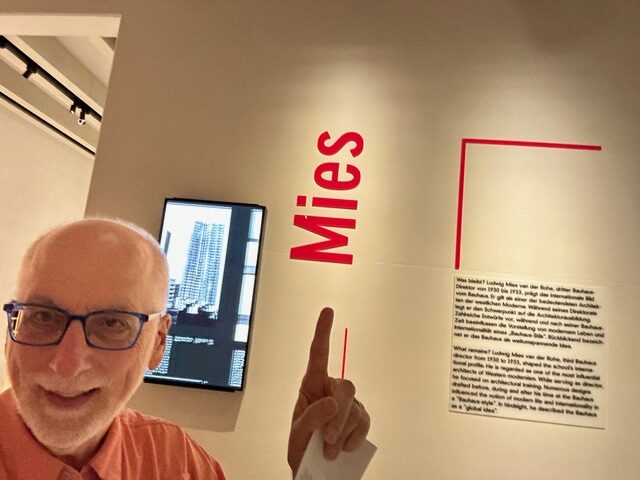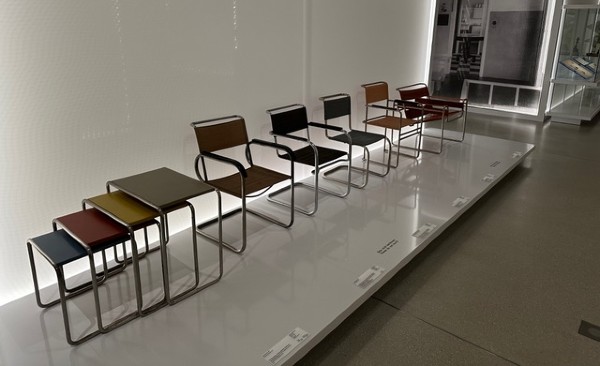
by Greg Dreyer, class of 2007
Photos by the author
It all started with an article my cousin sent me titled, “On the Bauhaus Trail in Germany,” by Charly Wilder and published in the New York Times in 2016. Leading up to the Bauhaus centenary in 2019, the author traveled through Germany to visit sites associated with the Bauhaus School. After reading the article, I thought—I want to do my own Bauhaus tour, and I put it on my list of future trips. Seven years later, I finally did it!
The Bauhaus School only existed for 14 years, from 1919 to 1933. The school was founded in Weimar under the direction of Walter Gropius in 1919. It was a government funded school and was therefore subject to changing political tides. By 1925, the regional government forced the Weimar school to move to Dessau, where the local government and the local industrial businesses welcomed the school. By 1932, however, the Nazis were in power in local government, and school funding was withdrawn. Finally, the school moved to Berlin in 1932, closing in 1933. Ludwig Mies van der Rohe was its last director.
The Bauhaus philosophy brought together the craft, art, and technology that would result in mass production and functional design. Bauhaus design principles influenced the modernist movement worldwide in later years as many of the Bauhaus professors and students immigrated to other parts of the world. Today, the cities of Weimar, Dessau, and Berlin are home to Bauhaus museums and UNESCO World Heritage designated Bauhaus buildings. I planned a trip to Germany to include as many as I could. Weimar is where it all began.
Weimar is a picturesque city of 65,000 people, located about 50 miles southwest of Leipzig. It was home to writers Johann Wolfgang von Goethe and Friedrich Schiller. Composer Franz Liszt also lived there. Weimar is where Germany’s first democratic constitution was signed after World War I. This political era between 1919 and 1933 is known as “the Weimar Republic.” The city actively promotes its cultural heritage as well as its distinction as the first Bauhaus School. The city is a tourist attraction for Germans exploring their cultural heritage but is not an international tourist draw. Therefore, English is not as widely spoken as in the larger cities. So, I had to rely on my German while in Weimar.
After arriving by train, I was perusing a tourist magazine. An article stated that 2023 is the 100th anniversary of the well-known and influential Bauhaus Exhibition, as well as the 100th anniversary of the construction of the Haus am Horn, one of the first houses built using Bauhaus design principles. To celebrate, the city scheduled a Bauhaus parade the very evening I arrived. This was a bit of local flavor that I just couldn’t miss. The Bauhaus parade consisted of a few musicians and people wearing funny hats, beginning at the Bauhaus University. Then the group of approximately 200 people marched to a nearby park. It was fun to be a part of this parade.


Weimar, Dessau, and Berlin each have Bauhaus museums, and they are good places to gain an understanding of the Bauhaus School. Weimar’s museum was completed in 2019, in time for the Centenary. The architect was Professor Heike Hanada, laboratory for art and architecture (sic), Berlin.


Museum exhibits are written in German and English. The audio guide, available in English, was very helpful. This museum covered all the art forms that were present at Bauhaus, including theater, which I didn’t know about. The museum also exhibits paintings by Bauhaus artists that were confiscated by the Nazis as “degenerate art.”




After a visit to the museum, I caught a 2.5 hour-long walking tour at the current Bauhaus University. Led by an architecture student, this tour includes areas in the university buildings that are not open to the public. The building above is one of two buildings that housed the Bauhaus School, 1919-1925 and designed by Henry van de Velde, circa 1904, for the Bauhaus predecessor School of Arts and Crafts. Today, it is the Main Building of the Bauhaus University.


During this German language tour, my years of studying German didn’t help much, but I could pick out a few words here and there and understand the gist of what the guide was saying.

Our final stop was Haus am Horn, designed by architect Georg Muche, 1923, along with Bauhaus students. Innovations such as flexible floor plans and prefabricated construction were introduced with this home. 
The original floor plan is indicated in white. The gray shaded rooms were added later by various owners. These were torn down when the house became a museum.“On the Bauhaus Trail” continues next week with a visit to the Bauhaus School’s second home in Dessau.
CLICK HERE for more stories on The Bridge.


Hi Greg – GREAT article!! I always talk about it on my river tours. Lots of good info and photos. It must have been a very special trip, especially for a CAC docent!
Claudia
Thank you, Claudia. Just wait until next week’s article on Dessau–home to more Bauhaus buildings than any other city worldwide! It was indeed a dream come true for this docent.
Great information, Greg. I didn’t realize that you could tour these places. Tom
Thanks! Seeing the interiors of the university buildings is only possible on a German language tour. No English tours are offered. The Bauhaus Museum and Haus am Horn are open to the public.
Looks like there was also an anti-nuclear weapons theme to the parade – or at least part of it! The banner reads “Bauhaus Out of NATO.” Tom Lenz
I’m not quite sure what that banner was supposed to mean.
Thanks for the wonderful travelogue into places I’ve heard about but not really thought about much in depth. Makes me want to go back to Germany. And I look forward to the rest of the story next week. Thanks, Greg.
Thanks, Ellen!
Thanks, Greg, for your interesting article. I look forward to your next article. I’m curious if traditions and principles from the original Bauhaus School are taught at the current Bauhaus University as part of its ongoing curriculum vs. limited to of historical lessons?
I am not sure, but this link to the university may provide some clues. The student tour guide did give an overview of the university, but she was talking way too fast for me to comprehend! https://www.uni-weimar.de/en/university/start/